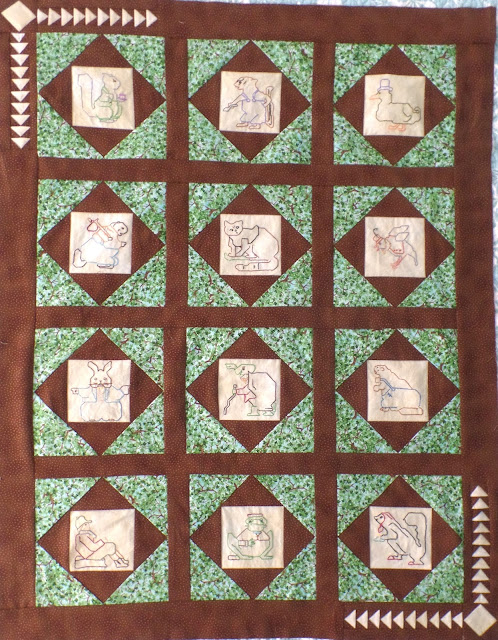In 1916, Ruby Short submitted a quilt pattern to the Kansas City Star newspaper as part of a competition to promote a children's book written by Thornton Burgess.
Burgess was a very popular children's writer. His children's stories were syndicated and published throughout the U.S. and Canada.
1915
Ruby's patterns were published in the Kansas City Star in 1916. Her designs are generally regarded as the first syndicated pattern series in a newspaper.
Ruby had long had an interest in art. Her passion for art seems to have outweighed her interest in needlework. When I emailed Ruby's granddaughter and asked about the kinds of quilts Ruby made, Merrily wrote back: "Grammy didn't make the quilts, she was way too busy designing and marketing the Studio."
When Ruby was young, she attended the New York School of Fine and Applied Arts (now Parsons School of Design). She appears to have been greatly impacted by the philosophy of Frank Alvah Parsons who felt that art should be accessible to everyone. Ruby graduated in 1912.
You can see some of Ruby's paintings here on the McKim Studios website.
Ruby returned home and taught art in locals schools. She even became the Supervisor of Drawing for the Independence School System. Many sources site that it was a good thing her designs were accepted by the Kansas City Star. In 1917 Ruby married Arthur McKim and as a married woman, could no longer work at the school.
What's A Quaddy?
Well the word "quaddy" is a nickname for a quadruped: an animal that has four feet, especially an ungulate mammal (with hooves). It's a weird term to use but was probably more known more at the early part of the 20th century. Burgess' characters were actually more woodland animals (including reptiles and birds).
Ruby's designs rendered her animals in an angular manner:
The patterns were meant for not only adults to make but especially for children to sew. As a school teacher, Ruby was well aware that embroidery was part of the curriculum in schools. In fact, an 1898 manual from a Normal (teaching) School cites:
"(embroidery provides) an educational means by which the brain is developed through the use of the hand..."
Today we refer to that as "hand-eye coordination." The patterns were meant to be traced onto fabric. The angular nature of the characters were easier for youngsters to trace and sew.
Above: a quilt top from my collection. What I like about this piece is that it includes the description of the character embroidered beneath the image like the original syndicated pattern. Many of the quilts made later just featured the animal.
The quilt could also be made from pre-printed squares. This ad ran in 1916:
Well yes they did but then it is the 21st century and the question I received from neighborhood children was why the characters were only depicted with blue thread. They wanted color on their animals.
So I made a wall hanging of more colorful embroidery:
My young audience preferred the more colorful embroidery but wanted to know why I hadn't colored in the animals (everyone's a critic 😄).
Soon the Quaddy Quiltie pattern was being syndicated all over the country. There were even parties that featured a quaddy theme:
As I had discussed during the Story Time Stitches series, popular children's books often could be marketed in a variety of ways. There were even "Bedtime Stories" party invitations marketed.
The success of the Quaddy Quiltie continued for years. Would you make a Quaddy Quiltie for a child you know?
Have a safe and happy day!













No comments:
Post a Comment